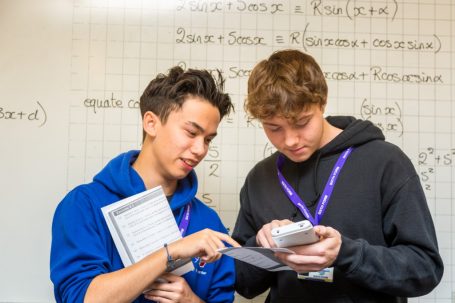This module teaches the ability to be able to understand and use the structure of mathematical proof, proceeding from given assumptions through a series of logical steps to a conclusion; use methods of proof, including proof by deduction, proof by exhaustion, disproof by counter example and proof by contradiction.
A Level Mathematics Year 12 & 13
Year 12 & 13 A Level Mathematics Course Modules
Algebra and Functions
This is detailed and extended work based on the skills already taught at GCSE.
Coordinate Geometry in the (x, y) plane – this is a development of the work at GCSE and introduces parametric equations and their uses.
Sequences and Series
This module covers the Binomial, Arithmetic and Geometric Sequences as well as Sigma notation.
Trigonometry
Radians, cosecant, secant, cotangent, arcsine, arccosine, and arctangent are all introduced. Trigonometric identities are sued to solve trigonometric equations in a given interval and the use of double angle formulae is expected.
Exponentials and Logarithms
This entails a detailed look at exponential and logarithmic functions leading to being able to understand and use exponential growth and decay and the use in modelling real world problems such as; continuous compound interest, radioactive decay, drug concentration decay. A consideration of limitations and refinements of exponential models is expected.
Differentiation
This is the related rate of change of one variable with another. Students will be expected to know, understand and be able to use differential calculus to differentiate using; product rule, quotient rule and the chain rule, including problems involving connected rates of change and inverse functions. They will also be expected to differentiate simple functions and relations defined implicitly or parametrically, and construct, and solve, simple differential equations in both pure mathematics and in context.
Integration
Students will be expected to know and use the Fundamental Theorem of Calculus, evaluate definite integrals, find the area under a curve and the between two curves and understand and use integration as the limit of a sum. They will also be expected to evaluate the analytical solution of simple first order differential equations with separable variables, including finding particular solutions, and then interpret the solution in the context of solving a problem, including identifying the limitations of the solution; this includes links to Mechanics.
Numerical Methods
This consists of methods such as Iterative, Newton-Raphson, Recurrence and Trapezium to solve problems.
Vectors
Students will be expected to calculate the magnitude and direction of a vector and convert between component and magnitude/direction forms. They will also be expected to understand and use position vectors, calculate the distance between two points and use vectors to solve problems in both Pure Mathematics and Mechanics.
Quantities and units in Mechanics
Students will be expected to understand and use fundamental quantities and units in the SI system; length, time, mass as well as understand and use derived quantities and units such as velocity, acceleration, force, weight, and moment.
Kinematics
This is the study of motion. Students will be expected to understand, know, and interpret graphs in kinematic for motion in a straight line. They will also be expected to use calculus in kinematics for motion in a straight line and extend this into 2D using vectors.
Forces and Newton’s Laws
Students will be expected to understand and use Newton’s Laws and their application to problems involving smooth pulleys and connected particles. They will be expected to resolve forces in 2D, find the equilibrium of a particle under coplanar forces, understand, and use addition of forces, resultant forces, and dynamics for motion in a plane. They will also understand and use the F≤µR model for the motion of a body on a rough surface and limiting and statics.
Moments
Students will be expected to understand and use moments in simple contexts.
Statistical Sampling
Students will know and use the terms “population” and “sample,” be able to use samples to make informal inferences about the population, understand and use sampling techniques including random and opportunity sampling and then select and critique sampling techniques in the context of solving problems, including understanding that different samples can lead to different conclusions about the population.
Date presentation and Interpretation
Students will be expected to interpret measures of central tendency and variation, be able to calculate and use standard deviation, including from summary statistics, and recognise and interpret possible outliers in data sets and statistical diagrams. They will also be able to select/critique data presentation techniques and be able to “clean” data, including dealing with missing data, errors, and outliers.
Probability
Students will be expected to model with probability, including critiquing assumptions and the likely effect of more realistic assumptions.
Discrete Random Variables and Expectation
Students will be able to understand a DRV and calculate probabilities and the mean, mode, variance, standard deviation, and expectation of a DRV. They will also look at the proof of the mean and variance of discrete uniform distributions.
Statistical distributions
Students will be able to use the Normal distribution as a model, find probabilities using this model and the link to histograms, mean, standard deviation, points of inflection and the binomial distribution. They will be able to select an appropriate distribution for a context, with appropriate reasoning, including recognising when the binomial or Normal model may not be appropriate.
Statistical Hypothesis Testing
Students will be able to conduct a statistical hypothesis test for the mean of a Normal distribution with known, given, or assumed variance, and interpret the results in context.




